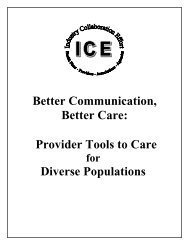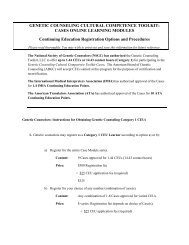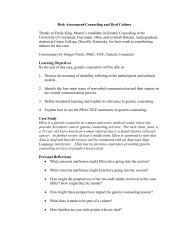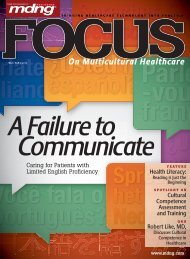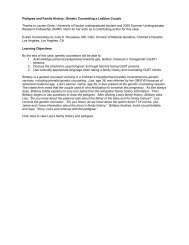Advanced Effective Communication, Cultural Competence, and ...
Advanced Effective Communication, Cultural Competence, and ...
Advanced Effective Communication, Cultural Competence, and ...
Create successful ePaper yourself
Turn your PDF publications into a flip-book with our unique Google optimized e-Paper software.
A Roadmap for Hospitals<br />
Appendix D: Laws <strong>and</strong> Regulations<br />
in an undue burden or fundamental alteration in a program<br />
or activity [12]:<br />
• Deny the opportunity to participate in or benefit from the<br />
aid, benefit, or service<br />
• Afford an opportunity to participate in or benefit that is<br />
not equal to that afforded others<br />
• Provide an aid, benefit, or service that is not as effective as<br />
that provided to others<br />
• Provide different or separate aid, benefit, or service unless<br />
such action is necessary to provide aid, benefit, or service<br />
that is as effective as those provided to others<br />
• Aid or perpetuate discrimination by providing significant<br />
assistance to an agency, organization, or person that discriminates<br />
on the basis of h<strong>and</strong>icap<br />
• Deny the opportunity to participate as a member of planning<br />
or advisory boards<br />
• Otherwise limit the enjoyment of any right, privilege, advantage,<br />
or opportunity enjoyed by others receiving an<br />
aid, benefit, or service<br />
Similarly, under federal law, hospitals cannot take any of the<br />
following actions toward qualified individuals with disabilities,<br />
on the basis of the disability, unless to do so would result<br />
in an undue burden or fundamental alteration in a program<br />
or activity [6]:<br />
• Establish or apply eligibility criteria for receipt of services<br />
or participation in programs or activities that screen out or<br />
tend to screen out individuals with disabilities, unless such<br />
criteria are necessary to meet the objectives of the program<br />
• Provide separate or different benefits, services, or programs<br />
unless it is necessary to ensure that the benefits <strong>and</strong><br />
services are equally effective<br />
• Refuse to allow a person with a disability to participate in,<br />
or benefit from, their services, programs or activities<br />
Further, these covered entities must, unless to do so would result<br />
in an undue burden or fundamental alteration in a program<br />
or activity, do the following [6]:<br />
• Provide services <strong>and</strong> programs in the most integrated setting<br />
appropriate to the needs of qualified individuals with<br />
disabilities.<br />
• Make reasonable modifications in policies, practices, <strong>and</strong><br />
procedures to avoid discrimination on the basis of disability.<br />
• Make buildings accessible.<br />
• Provide auxiliary aids, at no additional cost, where necessary<br />
to ensure effective communication with individuals with<br />
hearing, vision, or speech impairments.*<br />
Examples of discrimination on the basis of disability would<br />
include failing to make reasonable modifications, provide auxiliary<br />
aids <strong>and</strong> services, or remove architectural barriers. Such<br />
failures effectively prevent people with disabilities from enjoying<br />
the goods <strong>and</strong> services offered in a public space. This<br />
means that hospitals must modify policies, practices, <strong>and</strong> procedures,<br />
when necessary, to allow people with disabilities to<br />
gain full <strong>and</strong> equal access to services, unless a requested modification<br />
constitutes a fundamental alteration of the health care<br />
service itself or an undue burden. For example, if a hospital<br />
had a policy of not providing assistance to patients with undressing,<br />
it would have to modify that policy if someone with<br />
mobility impairment required such assistance to receive a<br />
proper examination. Hospitals must also provide auxiliary<br />
aids <strong>and</strong> services such as sign language interpreters, assistive<br />
listening devices, <strong>and</strong> written medical information in such alternative<br />
formats as Braille <strong>and</strong> large print, unless the hospital<br />
can establish that doing so would fundamentally alter the nature<br />
of the health care service or constitute an undue burden.<br />
Finally, hospitals must remove architectural barriers, such as<br />
steps, narrow doorways, <strong>and</strong> inaccessible toilets, in existing facilities<br />
if doing so is “readily achievable.” New construction<br />
hospitals or those that undertake alterations to existing facilities<br />
must make sure that the new construction or alteration<br />
meets the higher st<strong>and</strong>ard of being readily accessible [13].<br />
Section 504 of the<br />
Rehabilitation Act of 1973 <strong>and</strong><br />
the ADA: Accessible Medical<br />
Facilities <strong>and</strong> Equipment<br />
Disability discrimination issues may arise across a broad range<br />
of situations in the hospital setting, including the accessibility<br />
of medical facilities <strong>and</strong> equipment. Both the HHS Office for<br />
Civil Rights <strong>and</strong> the DOJ have negotiated settlement<br />
agreements requiring medical facilities to make physical<br />
accessibility improvements. The Washington Hospital Center<br />
agreement presents one of the most comprehensive. Under<br />
the terms of the agreement, Washington Hospital Center<br />
agreed to do the following:<br />
• Create a minimum of 35 fully accessible patient rooms,<br />
with each including an accessible toilet room <strong>and</strong> an<br />
accessible shower (or access to one)<br />
* Auxiliary aids include such services or devices as: qualified interpreters, assistive listening headsets, television captioning <strong>and</strong> decoders,<br />
telecommunications devices for the deaf (TDDs), videotext displays, readers, taped texts, Braille materials, <strong>and</strong> large print materials.<br />
73



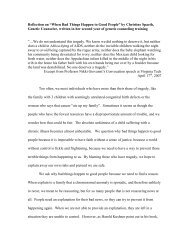
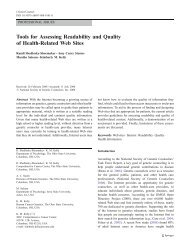

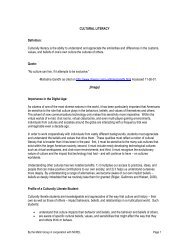
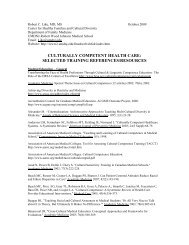

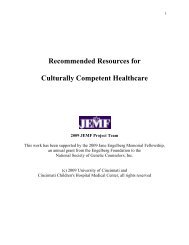

![Breaking Bad News PPT[1] - Genetic Counseling Cultural ...](https://img.yumpu.com/35003134/1/190x146/breaking-bad-news-ppt1-genetic-counseling-cultural-.jpg?quality=85)
